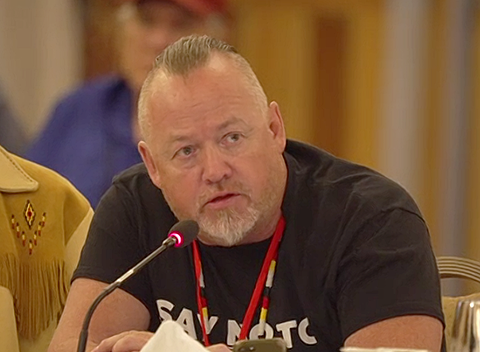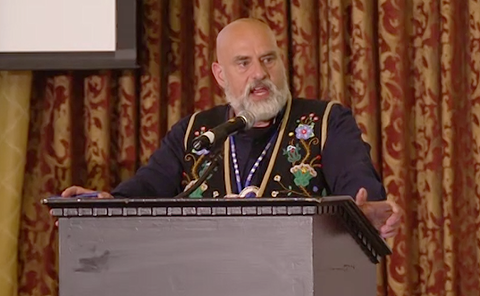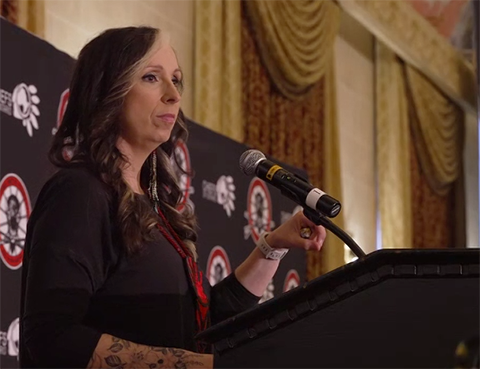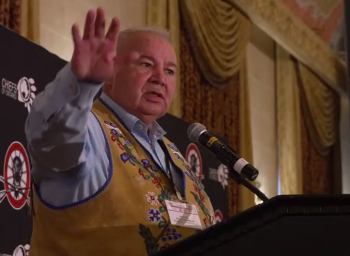Image Caption
Windspeaker.com
Regional Chief Glen Hare of the Chiefs of Ontario (COO) and Manitoba Métis Federation (MMF) President David Chartrand have signed a resolution to declare that the Métis Nation of Ontario (MNO) is committing Indigenous identity theft of the history and culture of the Red River Métis, “is not a legitimate organization representing legitimate Métis people” and that the communities represented by the MNO “did not exist historically in the Ontario region.”
The resolution further denounces MNO assertions in First Nations ancestral and treaty territories and its misuse of the Supreme Court of Canada Métis harvesting rights decision known as Powley “to serve MNO’s political agenda.”
It denounces the MNO’s “use of Red River Métis symbols and accusations that legitimate rights holders are committing lateral violence and perpetuating Métis denialism” by calling out MNO’s “false claims.”
It calls on Canada to reverse its “unfounded and unlawful” recognition of MNO by withdrawing Bill C-53, legislation that recognizes certain Métis governments in Ontario, Saskatchewan and Alberta. It calls on Canada to retract its support of the self-government agreement and to not introduce any further legislation that would recognize the MNO with having section 35 constitutional Indigenous rights.
The resolution also calls on the government of Ontario to retract its 2017 recognition of the MNO’s claims of six additional Métis communities in the province. It calls on both levels of government to discontinue engagement with the MNO and supplying it funds “earmarked for legitimate rights holders” and to cease accommodating Indigenous identity theft.
And the resolution calls on the Métis National Council to pull its support of Bill C-53 and to terminate its relationship with MNO.
So ended the first day of the Indigenous Identity Fraud Summit being held in Winnipeg.
MNO had not been invited, though its president did ask to be put on the agenda. In a statement released before the start of the summit, MNO said:
“MNO affirms its commitment to constructive dialogue and factual discourse regarding the rights and history of its communities. Historic rights-bearing Métis communities unquestionably exist in Ontario. This was definitively proven by the unanimous Supreme Court of Canada decision, R v. Powley. The MNO represents approximately 28,000 verifiable, rights-bearing Métis citizens in Ontario. We will defend our citizens and the Métis communities we represent.”

The summit began May 14 with a display of distinct Indigenous culture and traditions. Opening prayers were delivered by First Nations, Métis and Inuit Elders. A song was sung by First Nations around the big drum. Two Inuit women shared the origin story of, and showcased three songs in, the unique throat-singing style. A Métis man described the distinctive fiddle music of the Red River Métis and demonstrated by playing the Red River Jig.
Much of the first day of the summit was then spent defining who the true Métis are and who they are not. Summit presenters particularly denounced the rise of eastern Métis claims in Quebec and in Atlantic Canada.
The Métis Nation is not defined by having mixed blood, First Nations and European, presenters said. The real Métis are a distinct Indigenous people with a distinct language, history on the land in the western provinces, and a continuance of kinship, community and culture over the generations, MMF representatives said.
The Métis diaspora was driven west as Canada pushed from Ontario to take over Métis territory in what is now Manitoba, said Chartrand. It pushed Métis into Saskatchewan and then Alberta.
A small sliver in the most western part of Ontario has a historic Métis community, Chartrand conceded, but the Métis did not go farther east, he said.
Citizens of the Métis Nation, the section 35 rights-bearing people who fought for recognition up to the Supreme Court of Canada, must have ancestral ties to the “motherland” of the Red River, he said.
MMF Chief of Staff Al Benoit gave a 30-minute Métis history lesson during the summit to demonstrate that. He said those section 35 rights came at significant cost and weren’t easy to establish. Benoit challenged others who believe they have legitimate Indigenous rights to fund their own court battles and prove them themselves rather than ride on the coat tails of the Red River Métis.
At the summit, Chartrand, representing the Red River Métis, joined Chiefs of Ontario representatives to specifically target the MNO and its claims of six additional Métis communities in Ontario. That MNO citizenship, whoever they are, aren’t part of the authentic Métis Nation, they said.

MMF Housing minister Will Goodon said the Red River Métis were “drawing a line” about who belongs to the Métis Nation and who does not.
Identity fraud is “out of control,” said Chief Scott McLeod of Nipissing First Nation.
He said there has never been Métis in First Nations territories in Ontario. McLeod said they know that because the Elders tell them so and there is no word in their languages for Métis.
Chartrand said the Cree called the Métis people “Otipemisiwak”, the people who own themselves. Chartrand, though, said “Otipemisiwak” in the Saulteaux language, which Windspeaker has been told is similar to the Cree word.
Fakes, thieves and robbers—that’s what Chartrand called those who claim First Nations, Métis or Inuit identity without legitimate connection to those Indigenous peoples and their communities. Such individuals, and the collectives they establish, are a danger, he said. They harm legitimate Indigenous peoples.
That harm is caused by the authority fraudsters assert, by the opportunities and resources they take from actual Indigenous peoples, by the Indigenous knowledge systems they pollute, by the history they distort, and by the imposition on, and erosion of, established treaty, inherent and territorial rights.
This is what the gathering of First Nations, Red River Métis and Inuit representatives heard May 14. They heard from First Nations and Métis delegates who spoke emotionally about the impacts that identity fraud has had on their communities, from fraudsters being the lone “Indigenous” entity that industry consults on major projects, to students being taught made-up tales rooted in fallacies about Indigenous cultures and traditions.
The Indigenous Identity Fraud Summit was organized to shine light on the issue of identity theft and the impact inflicted on all sectors of Indigenous society. In recent years, many pretenders have been revealed in the arts and higher education, specifically.

Who are these fakes? According to summit presenter Dr. Pam Palmater, Indigenous advocate, scholar and podcaster, they are called by many names. Pretendians, Descendians, Wannabes, Wypipo, Fetis and Defendians are just some.
“This is one of the most important issues… existential as Indigenous nations… Things could be forever changed if we don’t stand up and fight for the integrity of our nations,” said Goodon.
But why now is there such a problem of non-Indigenous claiming to be Indigenous?
“At one time, nobody wanted to be us,” said Chartrand. “Nobody wanted to be connected to us. They were all ashamed saying they were First Nation or Métis of the Red River. They said, ‘holy, that’s a derogatory place to be. They’re the poor people. They’re the drunks. They’re nobodies. We don’t want to be them. We want to be somebody else’.”
But now First Nations, Métis and Inuit people are recognized in Canadian law as having section 35 rights. Now there are perceived benefits to being Indigenous, presenters said.
And now was the time to set things straight before further damage is done, said presenters. The fight to kill Bill C-35 legislation motivated MMF and the Ontario First Nations to organize the summit. Because, what would come next if that legislation was allowed to become law?
Chief McLeod spoke about system failures at all levels of government and in society that allow fakes to make illegitimate claims. Those failures must be addressed to blunt the further growth of fraudsters, he said. His own nation has re-evaluated its membership policies and protocols and is including more of its relatives on its membership list. That’s something that all nations could consider, he said.
The MNO statement said it was disappointing that the MMF and COO had chosen to exclude the MNO from participating in the Indigenous Identity Fraud Summit.
“This exclusion undermines the potential for a comprehensive and inclusive discussion on this critical issue affecting all Indigenous communities in Canada.
“Indigenous identity fraud is a serious issue that requires serious solutions. The MNO shares the MMF’s and COO’s concerns on this issue. But Indigenous peoples only lose when we fight amongst ourselves and approach self-determination as a zero-sum game. The only winners are colonial governments who find further reason to ignore our inherent rights and stand idly by.”
The Indigenous Identity Fraud Summit continues today with a focus on the Inuit.
To watch Day 1 of the Indigenous Identity Fraud Summit, go to YouTube at https://www.youtube.com/live/i-54weuHE2Y?si=GxHmQ_-LfshMBFIh
To watch Day 2 of the Indigenous Identity Fraud Summit, go to YouTube at https://www.youtube.com/live/fjNek3SYTpA?si=zaLyc_fb2AS0G3DN

